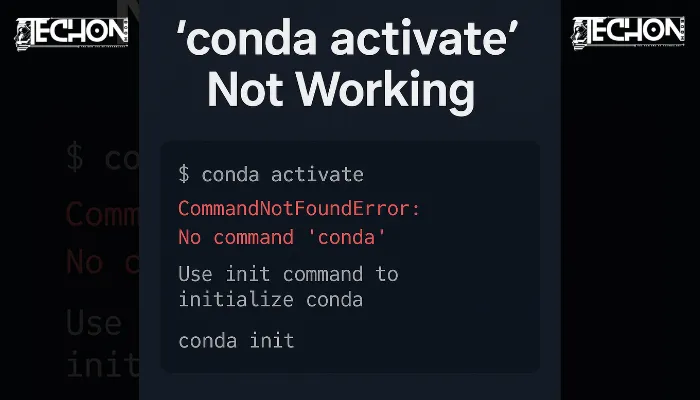If you are running “conda activate” in your terminal and nothing happens, or worse, you get an error like “CommandNotFoundError” or “conda is not recognized”, don’t panic. The fix is often straightforward.
Quick Fix:
Just run this command in your terminal:
conda initThen, restart your terminal and try:
conda activate baseThis simple command often solves 90% of issues with conda activate not working. But if you’re still stuck or want to understand why this happens and how to fix it permanently on Windows or Linux, read on.
Why conda activate Doesn’t Work
The conda activate The command is used to switch to a specific environment managed by Anaconda or Miniconda. However, if your system doesn’t recognize this command, it’s usually due to one of these issues:
- Your terminal shell has not been initialized to work with Conda.
- The Conda binary directory is not in your system PATH.
- You are using a terminal that does not load the Conda setup script.
- The installation was incomplete or corrupted.
- You are using an unsupported shell or environment, like vanilla
cmd.exeor a minimal Linux shell.
This is not a bug in Conda; it is just a setup issue that can be resolved.
How to Fix conda activate Not Working
Instructions: We will break down the solution into two sections based on your operating system.
Windows: Fixing conda activate Issues
1. Use the Correct Terminal:
Always use Anaconda Prompt, PowerShell, or Windows Terminal. Avoid plain cmd.exe, as it might not load Conda scripts properly unless explicitly configured.
- The best option is to search for “Anaconda Prompt” in your Start menu and open it.
- If you are using PowerShell, continue with the steps below.
2. Initialize Conda for Your Shell:
Run this in your terminal (Anaconda Prompt or PowerShell):
conda initThis will detect your current shell and configure the correct startup scripts (like PowerShell profile or .bash_profile).
You should see something like:
no change C:\Users\<User>\anaconda3\condabin\conda.bat
no change C:\Users\<User>\anaconda3\Scripts
...
modified C:\Users\<User>\Documents\PowerShell\Microsoft.PowerShell_profile.ps13. Restart Your Terminal:
Important: Close and reopen the terminal (or use exit and re-launch).
Now try:
conda activate base4. If Still Not Working, Manually Add Conda to PATH:
If the conda command is still not recognized, your environment variable might not include the Conda directory.
Do this:
- Go to Control Panel → System → Advanced System Settings → Environment Variables
- Under “System Variables”, find and edit the
Pathvariable. - Add these lines (adjust according to your user name and installation):
C:\Users\<YourUsername>\anaconda3
C:\Users\<YourUsername>\anaconda3\Scripts
C:\Users\<YourUsername>\anaconda3\Library\bin- Click OK, then restart your system.
Official Anaconda Installation Guide for Windows
Linux: Fixing conda activate Issues
1. Verify Conda is Installed:
Run:
which condaIf you get no output, Conda isn’t installed. Install Miniconda (lightweight version):
wget https://repo.anaconda.com/miniconda/Miniconda3-latest-Linux-x86_64.sh
bash Miniconda3-latest-Linux-x86_64.shFollow the on-screen prompts and allow it to initialize your shell at the end.
2. Initialize Your Shell for Conda:
If Conda is installed but conda activate still does not work, run:
conda init bashOr, for Zsh users:
conda init zshThis command edits your ~/.bashrc or ~/.zshrc file to automatically load Conda functions.
3. Reload Your Shell:
Apply the changes:
source ~/.bashrcNow, try activating Conda:
conda activate baseSuccess? Awesome. Still not working? Try the next step.
4. Manually Source Conda’s Script:
If you want a quick temporary solution without editing files:
source ~/miniconda3/etc/profile.d/conda.sh
conda activate baseTo make this permanent, add that source line to your shell’s RC file (~/.bashrc, ~/.zshrc, etc.).
Tips, Notes, and Warnings
- Use Miniconda if you prefer a lighter installation and greater control.
- Do not rely on
cmd.exe, as it lacks proper support for modern Conda setups. - Always restart the terminal after
conda init. - You can test environment switching by creating a dummy one:
conda create -n testenv python=3.10 -y
conda activate testenv- If all else fails, you can completely uninstall and reinstall Conda as a last resort.
Summary
Getting conda activate to work isn’t rocket science, it just requires your shell to be properly configured. Whether you’re on Windows or Linux, once conda init it’s done and the terminal is restarted, your Conda environments should work seamlessly.
If you ever run into issues again, revisit this guide or bookmark it for future reference. Happy coding with Conda!
If you found this helpful, you may also want to check out: Techonboom.

